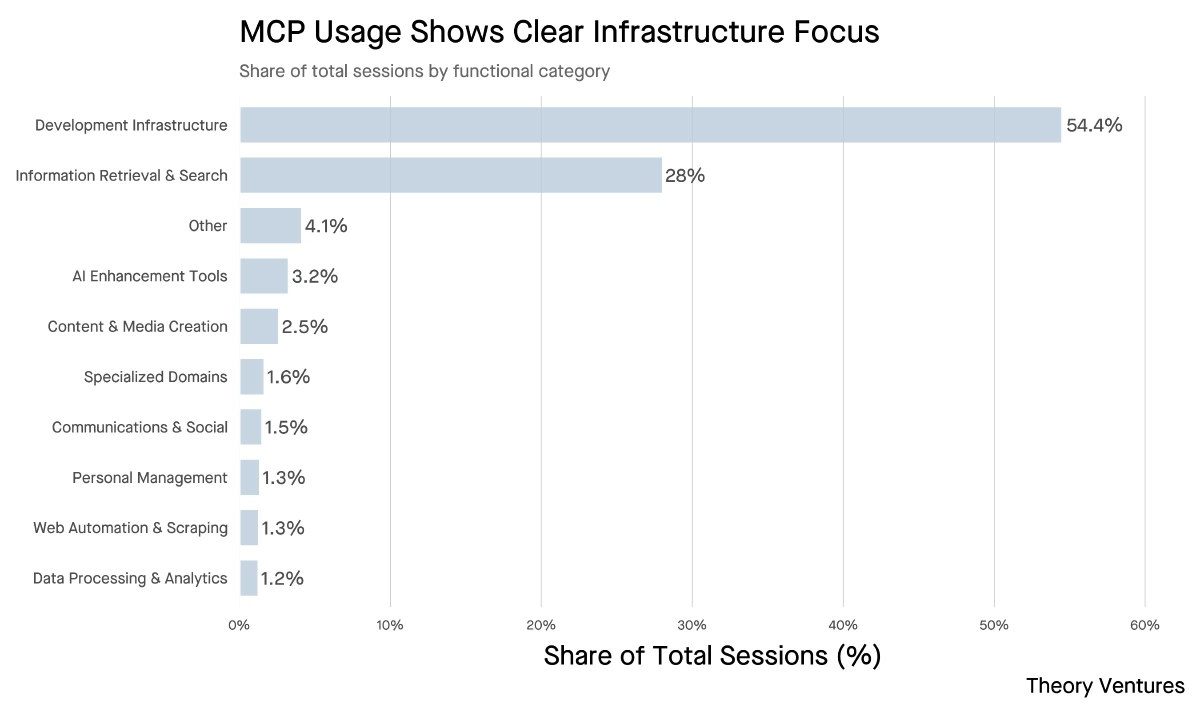10 Months of AI Agents: Discover the Most Popular Models in Use!
10 Months into AI Agents: Which Are Used Most?
When Anthropic introduced the Model Context Protocol (MCP), it promised to revolutionize the use of AI agents. MCP enables an AI to understand the various tools available to it, such as web search, file editing, and email drafting. Ten months later, we analyzed 200 MCP tools to understand which categories developers actually use. Our findings reveal intriguing insights into how these tools influence productivity.
Emerging Usage Patterns
Three distinct usage patterns have emerged from the data collected:
- Development Infrastructure Tools: Dominating with 54% of all sessions, despite representing only half of the available servers. Key functionalities include terminal access, code generation, and infrastructure access.
- Information Retrieval: Capturing 28% of sessions with a focus on utilizing AI for sourcing information efficiently.
- Communication Tools: Accounting for the remaining sessions, these tools facilitate seamless interaction among team members and stakeholders.
Distilling the Dominance of Development Infrastructure Tools
Within the realm of coding, engineers experience significant advancements in their workflows due to the capabilities offered by AI agents. The ability to push updates directly to GitHub, execute code in a terminal, and spin up databases are particularly notable. These functionalities streamline operations and minimize context switching, leading to notably improved productivity.
Future Possibilities of AI Agents
As we contemplate the future, the potential implications of widespread AI agent adoption are substantial. Imagine a scenario where:
- By 2025, AI agents are seamlessly integrated into everyday coding environments, significantly enhancing real-time collaboration among distributed teams.
- Businesses leveraging these tools experience a 40% reduction in project completion time, thanks to minimized delays caused by coding inefficiencies.
- The incorporation of machine learning algorithms allows AI agents to predict potential coding issues before they arise, dramatically reducing debugging time.
As AI liaisons, these agents could provide personalized insights, adaptive learning, and process optimizations that go beyond simple task execution.
Business Benefits and ROI
The integration of AI agents into development processes can profoundly benefit a business. Here are key advantages and examples of potential ROI:
- Enhanced Productivity: With streamlined workflows, developers can allocate time to higher-value tasks. For example, a software company could achieve savings of $100,000 annually as teams complete projects faster.
- Cost Reduction: By automating routine tasks, companies can reduce labor costs, with businesses reporting reductions in overhead by up to 20%.
- Improved Accuracy: AI agents help minimize human errors in coding, leading to fewer defects and potential cost savings in post-release bug fixes.
Actions for Implementation
For businesses to harness these benefits, several critical actions should be considered:
- Conduct a needs assessment to identify which AI tools align with project goals and developer requirements.
- Provide training sessions that familiarize team members with new AI tools to maximize their utility and adoption.
- Establish metrics to evaluate the effectiveness and ROI of AI integration post-implementation.
Conclusion and Call-to-Action
As we navigate the evolving landscape of AI agents, the potential to enhance development processes is vast. The observed usage patterns suggest that infrastructure tools will continue to dominate, with significant implications for productivity and efficiency. Don’t miss the opportunity to transform your business with AI capabilities.
Schedule a consultation with our team today to explore how you can implement these advancements and drive measurable benefits for your organization.


